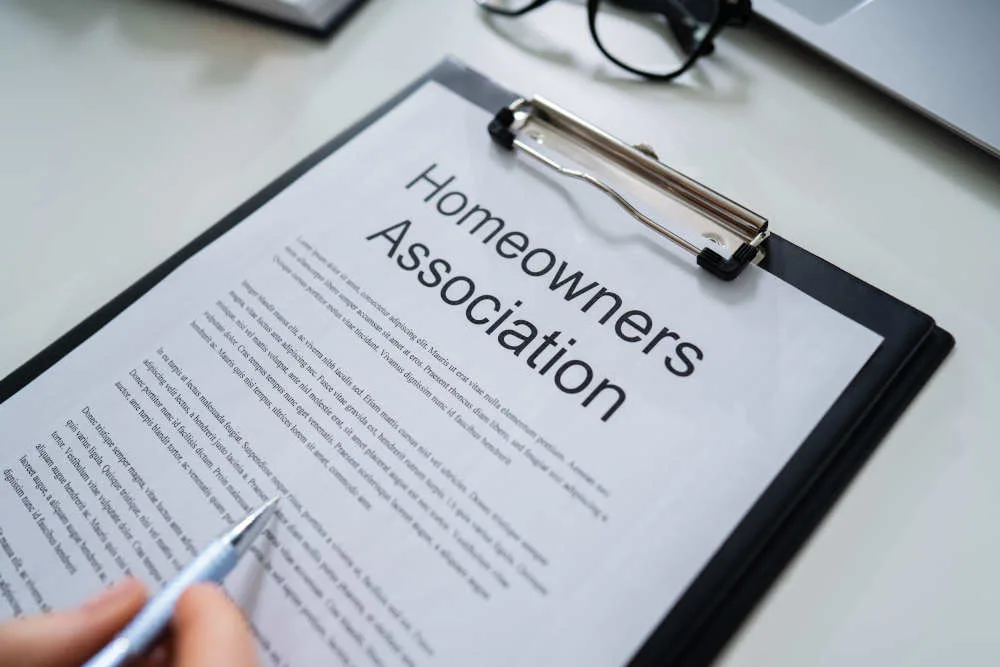

Dealing with an HOA isn’t always easy; just look at my article on the many reasons why HOAs are bad, and you will see what I mean. When you want to make changes to your yard, like putting up a fence, it’s especially difficult because it will influence the appearance of the neighborhood, so the HOA will be watching you closely. Because of this, it’s worth going through the proper approval process—you don’t want your HOA to fine you or even force you to tear down your new fence!
Let’s walk through how to get your fence approved by your HOA as quickly as possible. I have also included a sample letter to help get you started.

Research the latest CC&Rs for the fence-related rules, then present detailed plans to your HOA, even if your fence adheres to the specifications. Follow up with the HOA, and respond quickly to any further requests for information. Apply in writing and keep a copy of all physical documents submitted.
Anytime you’re dealing with an HOA, knowing the rules will always be to your advantage. Your HOA’s Covenants, Conditions, and Restrictions will set all the rules for your community, and they will almost certainly have information on installing fences.
Make sure you have the most updated CC&Rs when reviewing your fence requirements.
For instance, you might find specific instructions on the type of material, color, and how high you can build your fence. If you want a fence that doesn’t fit into these guidelines, you will have to file an appeal with your HOA board (or deal with the consequences). Some HOAs even have different regulations for fences in the front and back yards.
Each HOA has a unique set of rules, and they can be extremely specific, like exactly where and how tall you can build a fence. Some require you to submit fence plans for approval even if the fence was designed according to the CC&R specifications. Others will allow you to build a fence without approval as long as it fulfills the guidelines in the CC&Rs.
Either way, it’s best to present your plan to the HOA so that they at least have a heads up. That way, even if it’s not technically required, you’ve covered your bases if your HOA board members come calling after you put up your fence!

When you have your fence design prepared, submit a plan to your HOA with as much detail as possible. Include the material type, height, and blueprints. You could also add example pictures or digital mock-ups.
This is the time to meet with fence companies and get a few estimates. Ask them detailed questions about the installation so you can provide as much information to your HOA as possible. Ideally, choose a fence company that has worked in HOA communities before so that they will know what information you need to submit for approval.
You should keep copies of your letter and blueprints for yourself. You should also note the date and keep track of any follow-up on your request.
Scroll down to find a sample letter that you could send to your HOA to present the plan.
Like many organizations, HOAs are not always the fastest at responding. It can take a few weeks to get approval, and you should not start building your fence until you receive a response from your HOA.
We recommend following up with your HOA after a week to confirm that they’ve received your request. You can then follow up again if you still haven’t heard from them. Try to remain patient and be open and honest regarding your plans.
You should also request approval in writing, so you have it for your records.
If your plans are rejected, you should request to meet in person to learn what changes you can make to meet their approval.
It usually takes a few weeks to receive a final decision. A fast decision could come within a week, while a longer one could take up to nearly two months. However, the more details you provide to your HOA and if your fence is designed according to the CC&R, the faster the approval process typically goes.
Unfortunately, most HOAs don’t meet very frequently and can take a while to respond to requests. So, make sure to note how and when and with whom you followed up so that you can provide that information if your HOA is especially slow.
If they haven’t gotten back to you after three or four weeks, you should mention how many times you’ve followed up and that you will move forward unless you receive a response.
Ultimately, give yourself plenty of time for planning and building your fence so that you have space for delays.
Follow up – If the process is taking a while, you should follow up with your HOA regularly. Typically, you should hear from your HOA confirming receipt of your approval request within a week.
Meet in person – Additionally, you could try meeting in person with a member of the HOA board to discuss your plans and get feedback. This can speed up the process because then you have a friendly face on the inside!
Come prepared with your questions and only after having reviewed the guidelines yourself. Write down your specific questions so that you can discuss them together. You should document when and who you called and what you talked about.
Set a deadline – Finally, give your HOA a deadline for their response. HOAs are notoriously slow, but if you give them a deadline to work for, it might help. As humans, we are much more like to respond if we have a deadline we have to meet otherwise, procrastination is our natural tendency!
Of course, if your HOA has specific guidelines on a timeline for responding, then refer to that. Otherwise, suggest a deadline that is reasonable for both parties, typically between one and six weeks. The last thing you need is to garner your HOAs ire at the start of the process. Not all HOAs are petty, but it only takes one member to make your life unpleasant!

Do not approach your HOA with fencing plans without consulting your CC&Rs. You should know what is allowed first and only request approval for what will reasonably be approved. Otherwise, the HOA will likely deny your request, and you’ll be back at the drawing board, making the whole process take longer.
For example, most HOAs prohibit chain link, split rail, or wire containment fences because they are not as aesthetically appealing.
Additionally, if your plan is not approved, do NOT go ahead and build. Instead, submit an appeal for variance. You can request to alter your plans in a way that will appease the HOA requirements. You can meet with your entire board in person to submit altered plans and discuss ways to make it work.
Ultimately, you need to use open, honest, and polite commutation and remain patient. The more you communicate with your HOA, the easier it will be. And if you lose your patience, it will not end well for anyone!
Another factor to consider is how to approach your neighbors. Your fence installation or replacement will not be looked upon favorably if your neighbors are in stern opposition to its erection.
When writing to your HOA, keep it short and to the point but also polite. Remain firm on your position and leave room for follow-up. You should also anticipate any objections the board may have and include details or possible solutions that can solve them.
Use this template when writing a letter to your HOA requesting a fence. You should then mail in your letter and keep a copy for your records. Additionally, make sure you have provided a way for them to contact you to give you an answer to their decision.
From: John Doe
Address: 1234 Green Lane
Phone: 123-456-7890
Date: mm-dd-yyyy
TO: (Association name)
NOTICE IS HEREBY GIVEN OF THE FOLLOWING:
I am writing this letter to inform you of my intent to build a fence on my property.
I have reviewed the CC&Rs and consulted with (BOARD MEMBER NAME) about building a fence that will fit within HOA guidelines.
The fence will be made of __________ material. I have planned to build it ___ feet tall and ___ feet from my home. The dimensions will be _____ by _____. The color will be _______. (Add any additional information about your HOA-specific guidelines and your plan to follow them).
I have been in conversation with ______________ (construction company) for the building of this fence. I have also attached additional documents, including blueprints, for your further information.
I would like to begin building within ________ weeks, so kindly send confirmation of your receipt of this request as soon as possible and confirm that you can make a decision by then or suggest a reasonable date by which I can expect your decision.
If I have not heard from you within the next week, I will send a follow-up communication.
Sincerely,
(Your name/ signature)
ADDITIONAL MATERIALS: (Insert or attach fence blueprints, photographs, drawings, etc.)
mm-dd-yyyy
Here you can find a printable PDF of the fence approval sample letter.

HOAs can control practically any exterior change to your home because you technically only own the inside of the house, while the HOA owns the land and exterior. They can set rules as to the material, height, and location of fences as well as fence maintenance. If you break those rules, they can force you to remove or replace your fence. However, most HOAs will not prevent fences entirely; they just want you to build a fence that fits within their restrictions.
You can submit an appeal if you would like your HOA to approve something in your fence design that is not allowed in the CC&Rs. You may need to rally the support of your neighbors and/or join the HOA board yourself to make a change, but it’s not impossible.
Just keep in mind that if you want a fence sooner than later, it’s best to stick to the HOA guidelines because making changes to the HOA CC&Rs can take significant effort and time. I always like to ask myself: “Is this a hill that I am willing to die on?”
In some cases, an HOA may prevent fence installation entirely, and the way to find out if your particular HOA prohibits fence installation is to refer to the CC&Rs.
All of an HOAs’ rules are there to maintain a neighborhood’s standards, benefit all of the residents, and improve property values. However, it can often feel extremely nitpicky, especially with requirements for things like fences.
The reason HOAs have specific rules about fences is that fences can impact your neighbors’ views from their property. Many HOA communities are in areas with scenic locations such as near a beach, lake, or mountains. The residents there are paying for the views and investing in landscaping. They don’t want a fence in the way.
Furthermore, they don’t want their property values to be negatively affected by an “unsightly” fence. If the roles were reversed, you would not like to lose resale value because of your neighbor!
So, your HOA will set regulations accordingly.
Additionally, in some areas of the country where storms are common, if fences are not installed properly, they can rip apart, damaging nearby homes, backyard structures, and cars.
Florida, for example, is prone to hurricanes and high winds that can pick up your fence and cause serious damage or injury. In those areas, HOAs may restrict using wooden or other materials that could become dangerous, as well as require additional hardware to keep your fence in the ground.
Finally, your HOA wants to protect the appearance of the neighborhood. A well-designed fence can improve the curb appeal of your home, but a poorly designed one can distract from the sophisticated style your HOA is going for (often chain-link fences fall into this category).
Each community will have its own unique style they’re going for, so just be familiar with your HOA’s guidelines.
If you install a fence without HOA approval, you will likely face steep fines and have to replace it, leading to an annoying and stressful process that is likely to take longer and cost more than it ever should have.
It is your responsibility to get approval for your fence.
Your fence contractor may not be familiar with your community’s specific rules and regulations; although they can advise you about building your fence, your HOA will have a final say on the fence design.
You can and should consult a contractor before seeking approval to get an estimate, but do not engage them until you receive HOA approval.
If you put up a fence against your HOA’s CC&Rs, then you can face fines or even fence removal. They may just require you to replace it, working closely with the HOA board to design something that fits their guidelines. But even then, the last thing you want is for your fence to become the talk of the HOA board meetings and neighborhood gossip or have your neighbor complain about it every time you see them.
You wouldn’t think that something as simple as a fence could cause so much drama, but it’s happened time and time again with HOAs. The best way to avoid fines, delays, and neighborhood drama is to simply get the proper approval for your fence in the first place.
At the end of the day, open and frequent communication with your HOA can help prevent most issues. You should do your own research beforehand, make a detailed plan, and follow up with your HOA board as needed. Remain patient while waiting for a decision, and good luck!